1993 CHEVROLET SUBURBAN weight
[x] Cancel search: weightPage 87 of 386
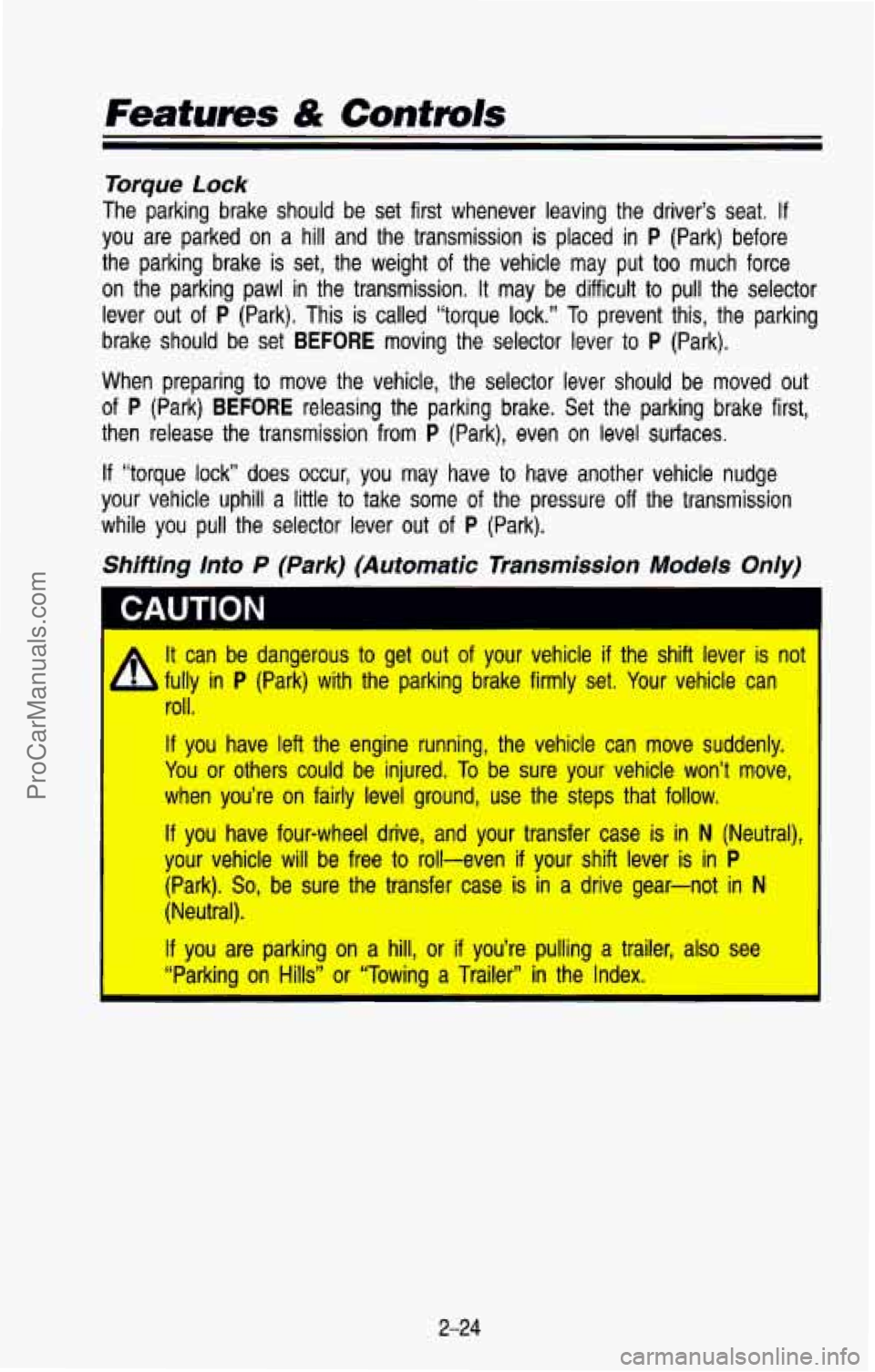
Features & Controls
Torque Lock
The parking brake should be set first whenever leaving the dri\
ver’s seat. If
you are parked on a hill and the transmission is placed in P (Park) before
the parking brake is set, the weight of the vehicle may put too much force
on the parking pawl in the transmission. It may be difficult to pull the selector
lever
out of P (Park). This is called “torque lock.” To prevent this, the parking
brake should be set
BEFORE moving the selector lever to P (Park).
When preparing to move the vehicle, the selector lever should be moved out
of P (Park) BEFORE releasing the parking brake. Set the parking brake first,
then release the transmission from
P (Park), even on level surfaces.
If “torque lock” does occur, you may have to have another vehicle nudge
your vehicle uphill
a little to take some of the pressure off the transmission
while you pull the selector lever out of
P (Park).
Shifting lnto P (Park) (Automatic Transmission Models Only)
It can be dangerous to get out of your vehicle if the shift lever is not I
A fully in P (Park) with the parking brake firmly set. Your vehicle can
roll.
If you have left the engine running, the vehicle can move suddenl\
y.
You or others could be injured.
To be sure your vehicle won’t move,
when you’re on fairly level ground, use the steps that foll\
ow.
If you have four-wheel drive, and your transfer case is in N (Neutral), I
your vehicle will be free to roll-even if your shift lever is in P
(Park). So, be sure the transfer case is in a drive gear-not in N
(Neutral).
If you are parking on a hill, or if you’re pulling a trailer, also see
I “Parking on Hills” or “Towing a Trailer” in the Index. I
2-24
ProCarManuals.com
Page 177 of 386
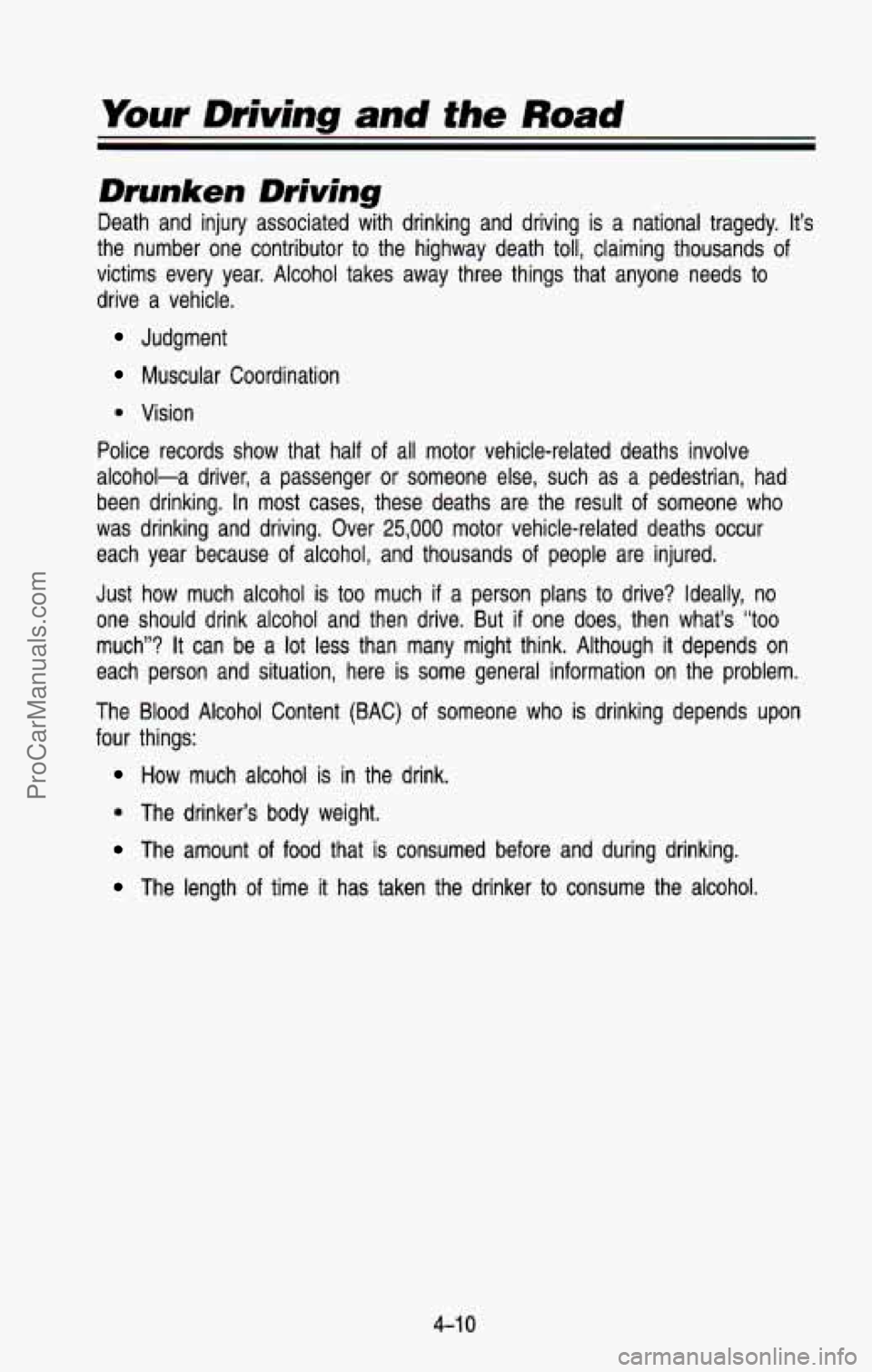
Drunken Driving
Death and injury associated with drinking and driving is a nat\
ional tragedy. It’s
the number one contributor to the highway death toll, claiming thousands of
victims every year. Alcohol takes away three things that anyone\
needs to drive a vehicle.
Judgment
Muscular Coordination
4 Vision
Police records show that half of all motor vehicle-related deat\
hs involve
alcohol-a driver, a passenger or someone else, such as a pedestrian, had
been drinking. In most cases, these deaths are the result
of someone who
was drinking and driving. Over
25,000 motor vehicle-related deaths occur
each year because
of alcohol, and thousands of people are injured.
Just how much alcohol
is too much if a person plans to drive? Ideally, no
one should drink alcohol and then drive. But
if one does, then what’s “too
much”? It can be a lot less than many might think. Although it depends on
each person and situation, here is some general information on \
the problem.
The Blood Alcohol Content (BAC)
of someone who is drinking depends upon
four things:
How much alcohol is in the drink.
4 The drinker’s body weight.
The amount of food that is consumed before and during drinking.
The length of time it has taken the drinker to consume the alcohol.
4-1 0
ProCarManuals.com
Page 199 of 386
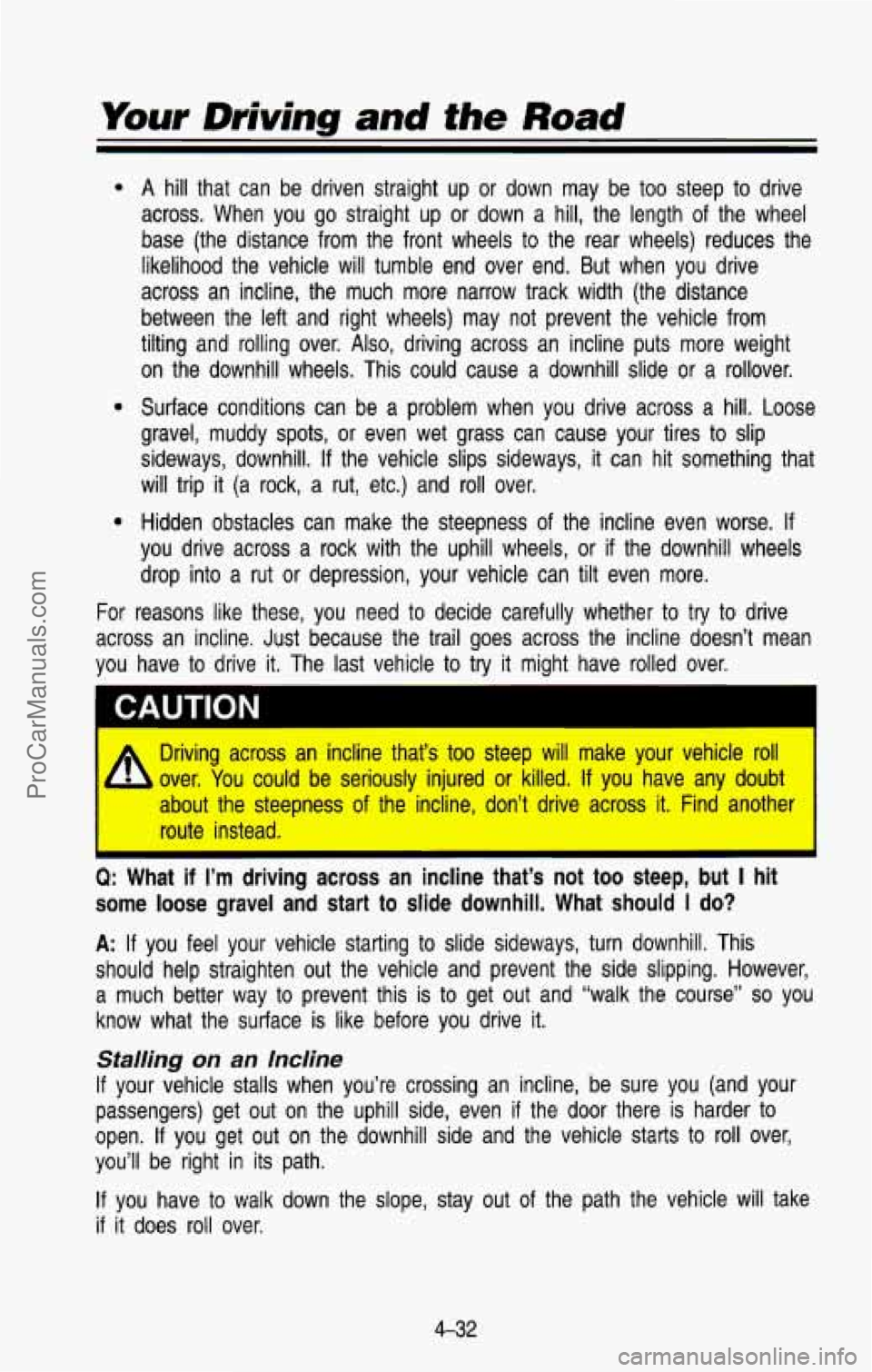
Your Driving and the Road
0
0
For
A hill that can be driven straight up or down may be too steep to drive
across. When you go straight up or down a hill, the length o\
f the wheel
base (the distance from the front wheels to the rear wheels) reduces the
likelihood the vehicle will tumble end over end. But when you drive
across an incline, the much more narrow track width (the dist\
ance
between the left and right wheels) may not prevent the vehicl\
e from
tilting and rolling over.
Also, driving across an incline puts more weight
on the downhill wheels. This could cause a downhill slide
or a rollover.
Surface conditions can be a problem when you drive across a
hill. Loose
gravel, muddy spots, or even wet grass can cause your tires to slip
sideways, downhill.
If the vehicle slips sideways, it can hit something that
will trip
it (a rock, a rut, etc.) and roll over.
Hidden obstacles can make the steepness
of the incline even worse. If
you drive across a rock with the uphill wheels, or if the do\
wnhill wheels
drop into a rut or depression, your vehicle can tilt even more.
reasons like these, you need to decide carefully whether to try to drive
across an incline. Just because the trail goes across the incline doesn’t mean
you have to drive it. The last vehicle to try it might have rolled over.
CAUTION
A
Driving across an incline that’s too steep will make your vehicle roll
over. You could be seriously injured or killed.
If you have any doubt
about the steepness of the incline, don’t drive across it. \
Find another route instead.
I
Q: What if I’m driving across an incline that’s not too steep, but I hit
some loose gravel and start
to slide downhill. What should I do?
A: If you feel your vehicle starting to slide sideways, turn down\
hill. This
should help straighten out the vehicle and prevent the side sl\
ipping. However, a much better way to prevent this is to get out and “walk the course”
so you
know what the surface is like before you drive
it.
Stalling on an Incline
If your vehicle stalls when you’re crossing an incline, be sure you (and your
passengers) get out on the uphill side, even
if the door there is harder to
open.
If you get out on the downhill side and the vehicle starts to roll over,
you’ll be right in its path.
If you have to walk down the slope, stay out of the path the vehicle will take
if it does roll over.
4-32
ProCarManuals.com
Page 219 of 386
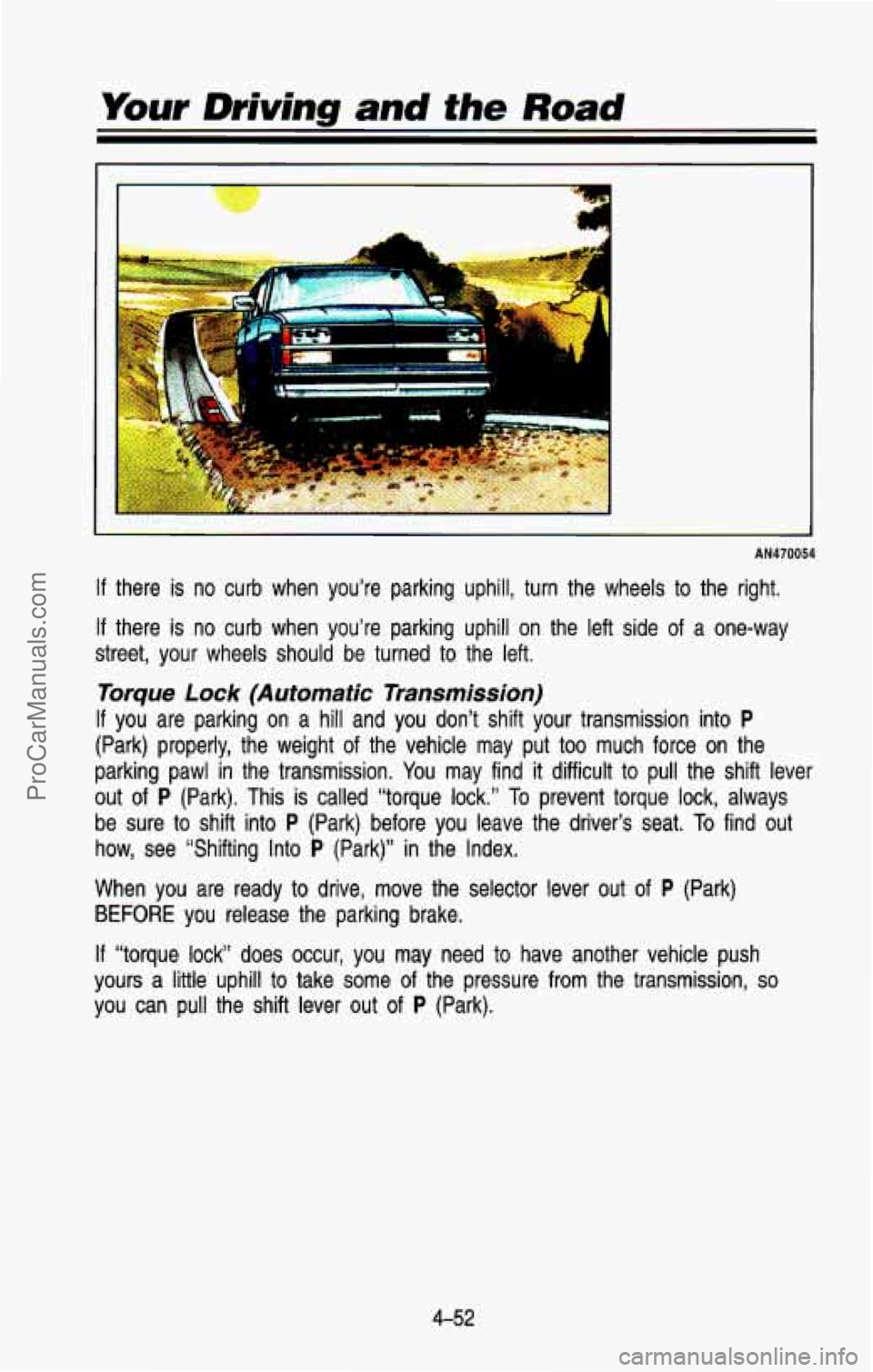
Your Driving and the Road
AN470054
If there is no curb when you’re parking uphill, turn the wheel\
s to the right.
If there is no curb when you’re parking uphill on the left si\
de of a one-way
street, your wheels should be turned to the left.
Torque Lock (Automatic Transmission)
If you are parking on a hill and you don’t shift your transmi\
ssion into P
(Park) properly, the weight of the vehicle may put too much \
force on the
parking pawl in the transmission. You may find
it difficult to pull the shift lever
out of
P (Park). This is called “torque lock.” To prevent torque lock, always
be sure
to shift into P (Park) before you leave the driver’s seat. To find out
how, see “Shifting Into P (Park)” in the Index.
When
you are ready to drive, move the selector lever out of P (Park)
BEFORE you release the parking brake.
If “torque lock” does occur, you may need to have another vehicle push
yours
a little uphill to take some of the pressure from the transmission, so
you can pull the shift lever out of P (Park).
4-52
ProCarManuals.com
Page 225 of 386
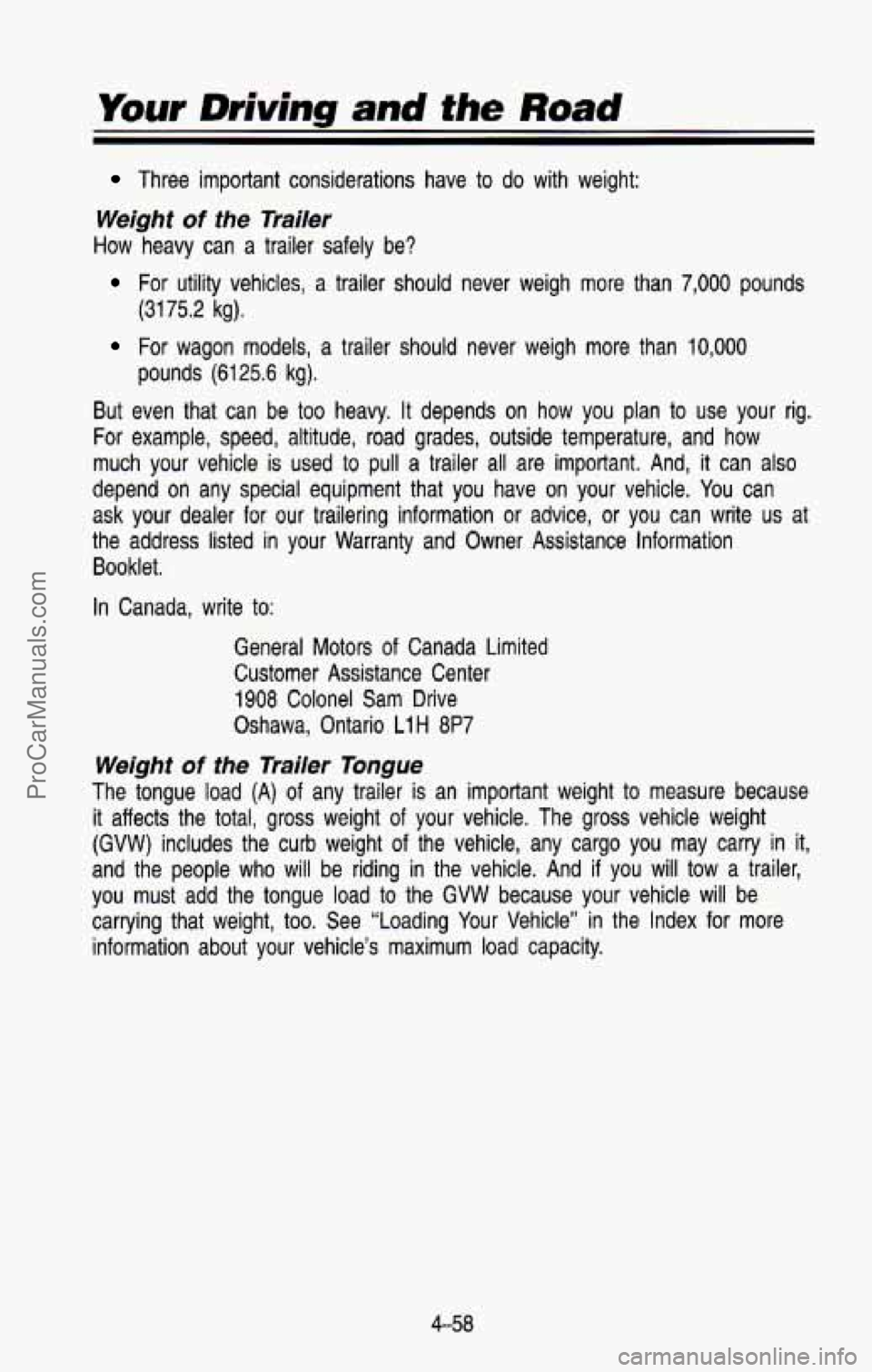
Your Driving and the Road
Three important considerations have to do with weight:
Weight of the Trailer
How heavy can a trailer safely be?
For utility vehicles, a trailer should never weigh more than 7,000 pounds
(31 75.2 kg).
For wagon models, a trailer should never weigh more than 10,000
pounds (6125.6 kg).
But even that can be too heavy. It depends on how you plan to use your rig.
For example, speed, altitude, road grades, outside temperature, \
and how
much your vehicle is used to pull a trailer all are important\
. And,
it can also
depend on any special equipment that you have
on your vehicle. You can
ask your dealer for our trailering information or advice, or y\
ou can write us at
the address listed in your Warranty and Owner Assistance Inform\
ation
Booklet.
In Canada, write
to:
General Motors of Canada Limited
Customer Assistance Center
1908 Colonel Sam Drive
Oshawa, Ontario
L1H 8P7
Weight of the Trailer Tongue
The tongue load (A) of any trailer is an important weight to measure because
it affects the total, gross weight of your vehicle. The gross vehicle weight
(GVW) includes the curb weight
of the vehicle, any cargo you may carry in it,
and the people who will be riding in the vehicle. And if you will tow a trailer,
you must add the tongue load to the GVW because your vehicle will be
carrying that weight, too. See “Loading Your Vehicle” in the Index for more
information about your vehicle’s maximum load capacity.
4-58
ProCarManuals.com
Page 226 of 386
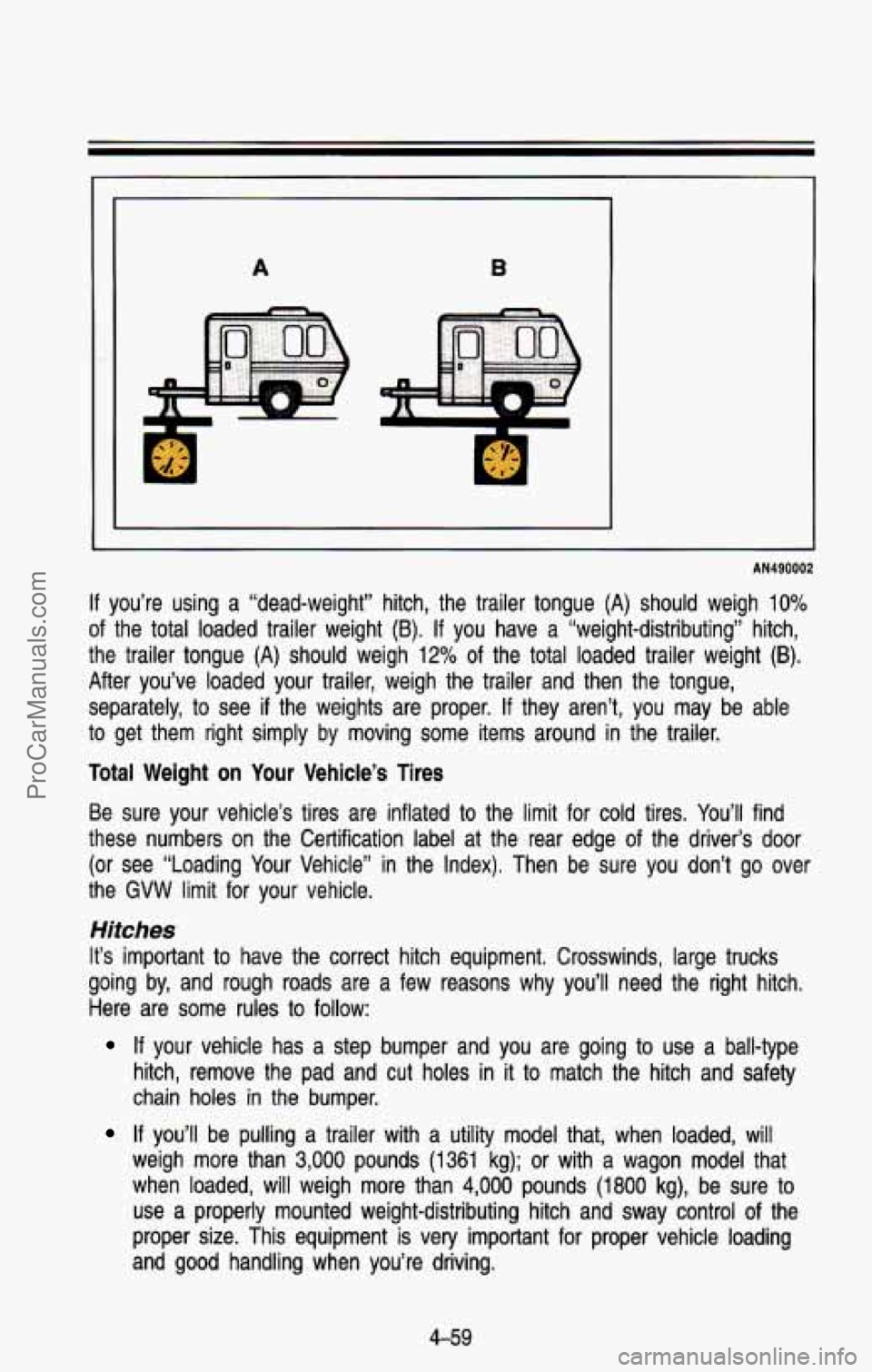
A B
AN490002
If you’re using a “dead-weight” hitch, the trailer tongue (A) should weigh \
10%
of the total loaded trailer weight (8). If you have a “weight-distributing” hitch,
the trailer tongue
(A) should weigh 12% of the total loaded trailer weight (B).
After you’ve loaded your trailer, weigh the trailer and then the tongue,
separately, to see if the weights are proper.
If they aren’t, you may be able
to get them right simply by moving some items around in the trailer.
Total Weight on Your Vehicle’s Tires
Be sure your vehicle’s tires are inflated to the limit for cold tires. You’ll find
these numbers on the Certification label at the rear edge of \
the driver’s
door
(or see “Loading Your Vehicle” in the Index). Then be sure you don’t go over
the
GVW limit for your vehicle.
Hitches
It’s important to have the correct hitch equipment. Crosswinds, large trucks
going by, and rough roads are a few reasons why you’ll need the right hitch,
Here are some rules to follow:
If your vehicle has a step bumper and you are going to use a ball-type
hitch, remove the pad and cut holes in it to match the hitch and safety
chain holes in the bumper.
If you’ll be pulling a trailer with a utility model that, when loaded, will
weigh more than
3,000 pounds (1361 kg); or with a wagon model that
when loaded, will weigh more than
4,000 pounds (1 800 kg), be sure to
use a properly mounted weight-distributing hitch and sway control
of the
proper size. This equipment
is very important for proper vehicle loading
and good handling when you’re driving.
4-59
ProCarManuals.com
Page 227 of 386
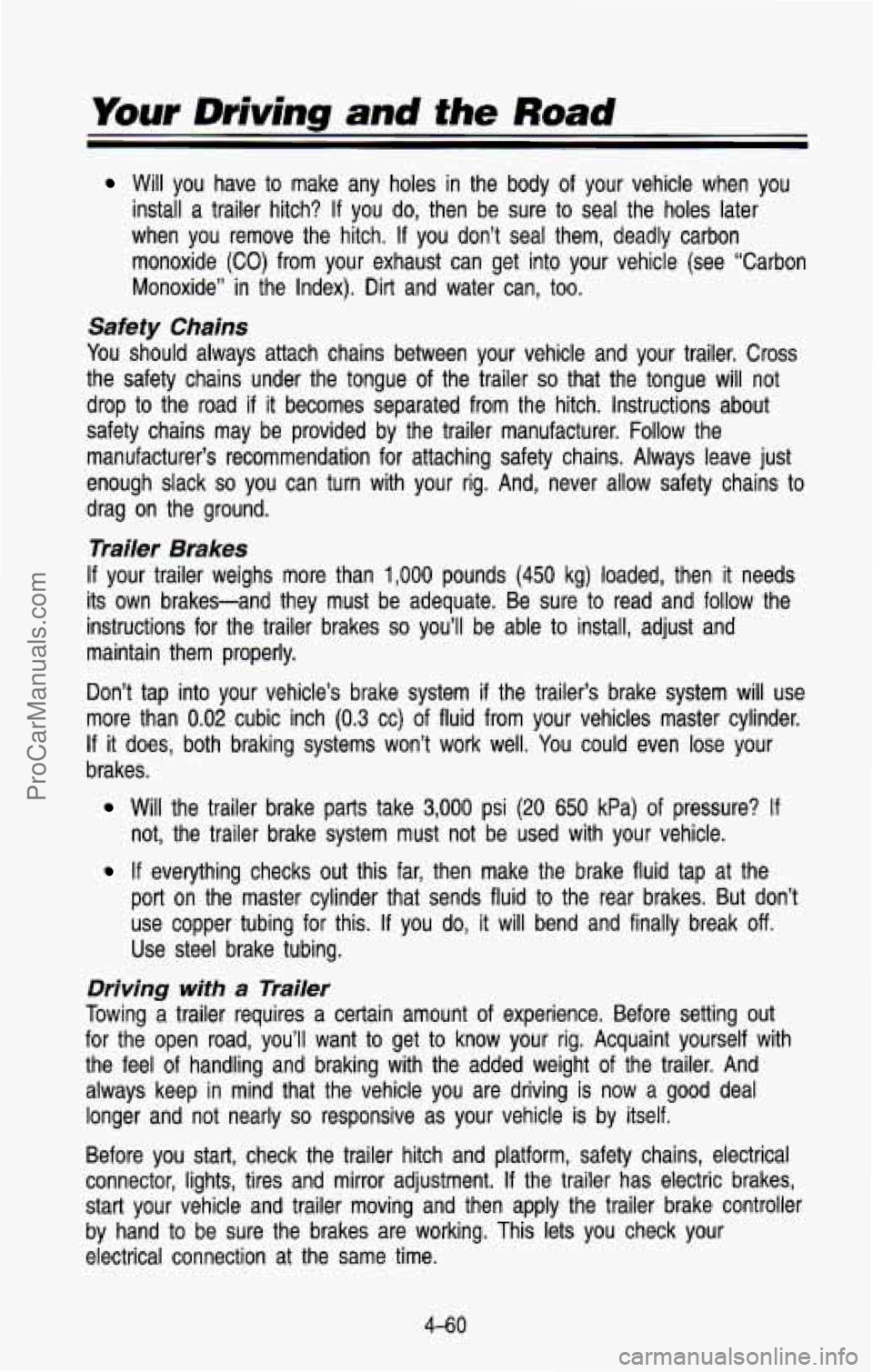
Your Driving and 0% Road
Will you have to make any holes in the body of your vehicle when you
install a trailer hitch?
If you do, then be sure to seal the holes later
when you remove the hitch.
If you don’t seal them, deadly carbon
monoxide
(CO) from your exhaust can get into your vehicle (see “Carbon
Monoxide” in the Index). Dirt and water can, too.
Safety Chains
You should always attach chains between your vehicle and your trail\
er. Cross
the safety chains under the tongue of the trailer
so that the tongue will not
drop to the road
if it becomes separated from the hitch. Instructions about
safety chains may be provided by the trailer manufacturer. Follow the
manufacturer’s recommendation
for attaching safety chains. Always leave just
enough slack
so you can turn with your rig. And, never allow safety chains to
drag on the ground.
Trailer Brakes
If your trailer weighs more than 1,000 pounds (450 kg) loaded, then it needs
its own brakes-and they must be adequate. Be sure
to read and follow the
instructions for the trailer brakes
so you’ll be able to install, adjust and
maintain them properly.
Don’t tap into your vehicle’s brake system if the trailer’s brake system will use
more than
0.02 cubic inch (0.3 cc) of fluid from your vehicles master cylinder.
If it does, both braking systems won’t work well. You could even lose your
brakes.
Will the trailer brake parts take 3,000 psi (20 650 kPa) of pressure? If
not, the trailer brake system must not be used with your vehi\
cle.
If everything checks out this far, then make the brake fluid tap at the
port on the master cylinder that sends fluid
to the rear brakes. But don’t
use copper tubing for this.
If you do, it will bend and finally break off.
Use steel brake tubing.
Driving with a Trailer
Towing a trailer requires a certain amount of experience. Before setting out
for the open road, you’ll want
to get to know your rig. Acquaint yourself with
the feel of handling and braking with the added weight of the trailer. And
always keep in mind that the vehicle you are driving is now a good deal
longer and not nearly
so responsive as your vehicle is by itself.
Before you start, check the trailer hitch and platform, safety \
chains, electrical
connector, lights, tires and mirror adjustment.
If the trailer has electric brakes,
start your vehicle and trailer moving and then apply the trail\
er brake controller
by hand to be sure the brakes are working. This lets vou check your
electrical connection at the same time.
4-60
ProCarManuals.com
Page 311 of 386
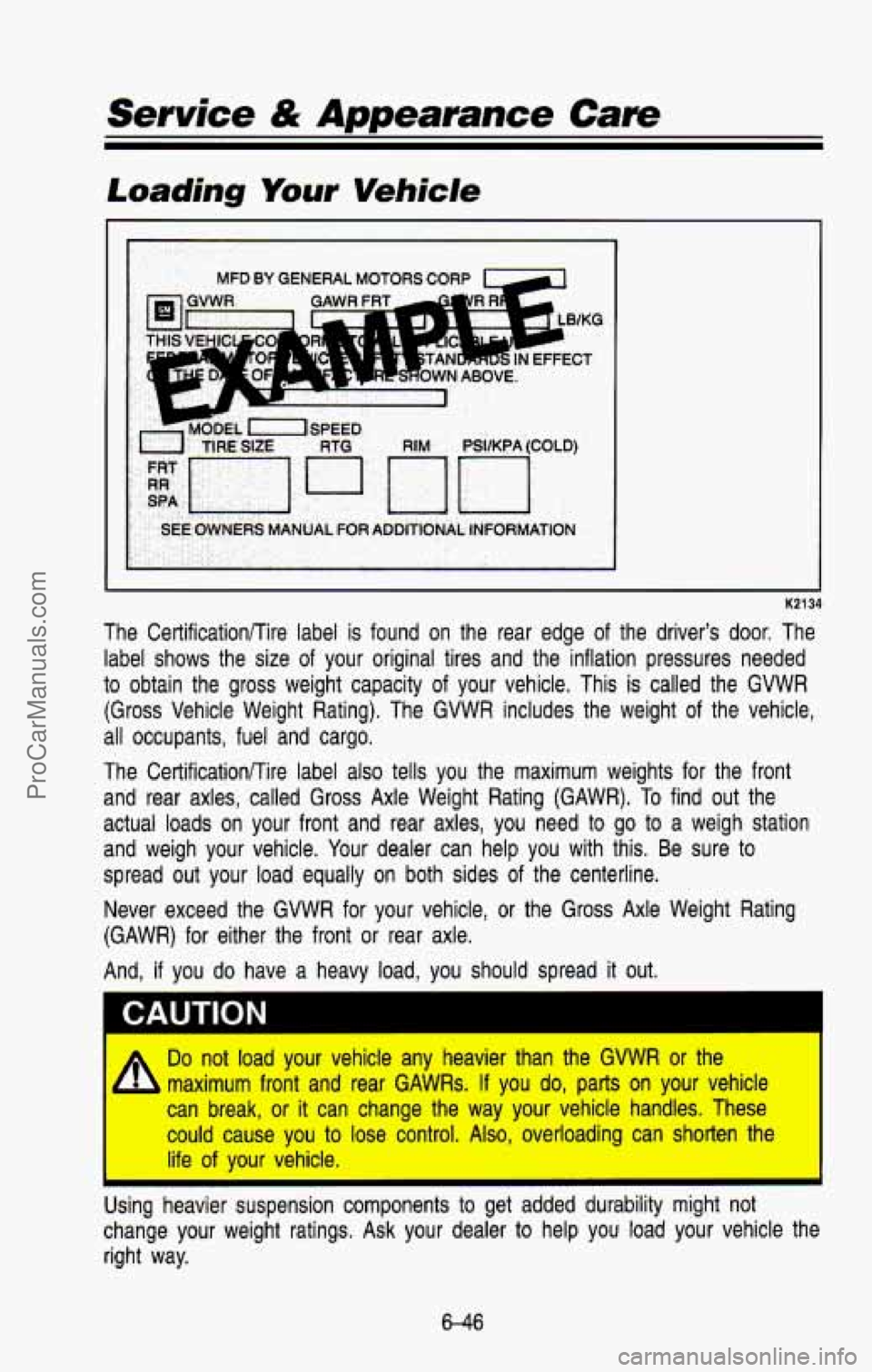
Loading Your Vehicle
MFD BY GENERAL MOTORS CORP L-4
I
. , .. .-. .. ,. . ,FFECT
CROWN ABOVE.
1
TIRE SIZE
-EL XISPEED RIM PSVKPA (COLD)
SPA
SEE OWNERS MANUAL FOR ADDITIONAL INFORMATION
K2134
The Certificationflire label is found on the rear edge of the driver's door. The
label shows the size of your original tires and the inflation \
pressures needed
to obtain the gross weight capacity of your vehicle. This is called the GVWR
(Gross Vehicle Weight Rating). The GVWR includes the weight o\
f the vehicle,
all occupants, fuel and cargo.
The Certificationnire label also tells you the maximum weights for the front
and rear axles, called Gross Axle Weight Rating (GAWR). To find out the
actual loads on your front and rear axles, you need to go to\
a weigh station
and weigh your vehicle. Your dealer can help you with this. Be sure to
spread out your load equally on both sides of the centerline. \
Never exceed the GVWR
for your vehicle, or the Gross Axle Weight Rating
(GAWR) for either the front or rear axle.
And,
if you do have a heavy load, you should spread it out.
A
Do not load your vehicle any heavier than the GVWR or the I
maximum front and rear GAWRs. If you do, parts on your vehicl\
e
can break, or
it can change the way your vehicle handles. These
could cause you
to lose control. Also, overloading can shorten the
life of your vehicle.
Using heavier suspension components
to get added durability might not
change your weight ratings. Ask your dealer to help you load your vehicle the
right way.
6-46
ProCarManuals.com